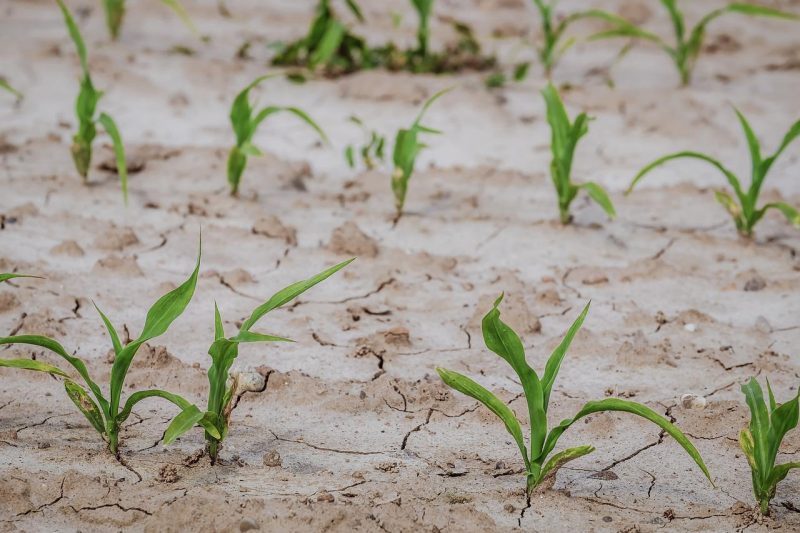Food doesn’t just magically show up at the grocery store. If farmers and ranchers do not produce it, we do not eat. I know that I have been writing about the rapidly growing global food crisis a lot lately, but that is because this really is a big deal. All over the globe, agricultural production is going to be below expectations in 2022. As a result, those of us that live in wealthy countries will pay much more for food in 2023, while many of those that live in poor countries will either deeply suffer or die. In fact, children are already dropping dead from starvation in large numbers in some parts of Africa, but most Americans haven’t heard about this because they aren’t showing it on the news.
Of course this isn’t just a crisis for poor countries on the other side of the planet.
Here in the United States, the food that is not being grown in 2022 will cause immense economic pain in 2023.
There are 17 western states that collectively produce almost half of our food, and right now those 17 states are being absolutely devastated by the worst multi-year megadrought in 1,200 years…
The 17 states including and north of Texas, up along the Central Plains to North Dakota and west to California are vital to the U.S. agricultural sector, supporting nearly half of the nation’s $364 billion production by value. This includes 74% of beef cattle, responsible (in total) for 18% of U.S. agricultural production by value; 50% of dairy production, responsible (in total) for 11% of U.S. agricultural production by value, over 80% of wheat production by value and over 70% of vegetable, fruit and tree nut production by value. Drought conditions, which have persisted well into 2022, put production of these commodities at risk, along with the stability of farms, ranches and local economies reliant on crops, livestock and downstream products and services for income.
The American Farm Bureau Federation wanted to know how farmers in that half of the nation are faring during this drought, and so they conducted a survey.
And what they discovered is extremely alarming. Here is one example…
This year’s drought conditions are taking a harder toll than last year’s, as 37% of farmers said they are plowing through and killing existing crops that won’t reach maturity because of dry conditions.
Do you understand what that is saying?
37 percent of all farmers in the western half of the country are killing their own crops because those crops won’t even reach maturity because of the endless drought.
I was absolutely floored when I first saw that figure.
And that same survey also found that staggering numbers of ranchers in some western states have been selling off their cattle…
Farmers in Texas are being forced to sell off their cattle herds earlier than normal due to extreme drought — as water sources dry out and grass burns up. Farmers in the Lone Star state reported the largest reduction in herd size, down 50%, followed by New Mexico and Oregon at 43% and 41% respectively.
The cattle that are being slaughtered now are helping to stabilize short-term beef prices.
But in the long run we will see a much smaller cattle population and far higher beef prices.
In fact, some beef producers in Oklahoma are warning that “cheap ground beef could eventually top $50 per pound”…
Thanks to the unending economic symptoms of the pandemic and 2022’s inflation double-punch, average beef prices are currently about twice what they were in 2019. Add in the deepening widespread drought, a shortage of hay and feed, skyrocketing prices, transport costs, and various other metrics, some Southwest Oklahoma beef producers suggest cheap ground beef could eventually top $50 per pound.
Could you imagine paying 50 dollars for a pound of ground beef?
Even now, we are being told that U.S. consumers are increasingly switching to chicken…
Inflation-weary shoppers are pulling back on buying pricey steaks and switching to cheaper chicken at the grocery store.
Tyson (TSN), the meat processing giant, said Monday that “demand for chicken is extremely strong,” while demand for its higher-priced cuts of beef has softened.
Of course it isn’t just the United States that is moving into unprecedented territory.
We just learned that there will be crop losses in France of up to 35 percent…
France’s fruit and vegetable crops have fallen by nearly 35% due to the extreme drought this summer, Jacques Rouchausse, president of the French national association of vegetable producers, Legumes de France, said on Tuesday.
“We have losses on the yields. For the moment, we estimate that these losses are between 25% and 35 percent. We have to stress that if we want food sovereignty, if we want food security, we really have to find ways to continue producing on our territory,” Rouchausse said on air of Radio Franceinfo.
Yesterday, I discussed the fact that there will be crop losses in the UK of up to 50 percent in some cases.
And in Italy, it is being reported that there will be crop losses of up to 80 percent in certain areas.
As global food supplies get tighter and tighter, the wealthy countries will have enough money to import the food that they need.
But what will the poorer countries do?
At this point, tens of millions of Africans are already dealing with severe food shortages…
Drought is gripping the Horn of Africa, leaving some 26 million people facing food shortages in Kenya, Ethiopia and Somalia over the next six months. More than 7 million livestock animals have already been wiped out. Across East Africa as a whole, some 50 million people are facing acute food insecurity.
This is a crisis that isn’t going away.
Not too long ago, UN Secretary General António Guterres openly admitted that it is likely that there will be “multiple famines” in 2023…
In a video message to the meeting, UN chief António Guterres commended the partners for joining forces at what he called “this critical moment”, noting that the number of people who are severely food insecure has doubled in the last two years.
“We face a real risk of multiple famines this year. And next year could be even worse. But we can avoid this catastrophe if we act now,” said Mr. Guterres.
Of course this is exactly what I have been saying for years.
Global famine is coming. There is no way to avoid it, and it is going to turn the entire global economy upside down.
When you know that a global famine is coming, the prudent thing to do is to get prepared. So I hope that all of you are taking action while there is still time to do so.
***It is finally here! Michael’s new book entitled “7 Year Apocalypse” is now available in paperback and for the Kindle on Amazon.***
About the Author: My name is Michael and my brand new book entitled “7 Year Apocalypse” is now available on Amazon.com. In addition to my new book I have written five other books that are available on Amazon.com including “Lost Prophecies Of The Future Of America”, “The Beginning Of The End”, “Get Prepared Now”, and “Living A Life That Really Matters”. (#CommissionsEarned) When you purchase any of these books you help to support the work that I am doing, and one way that you can really help is by sending digital copies as gifts through Amazon to family and friends. Time is short, and I need help getting these warnings into the hands of as many people as possible. I have published thousands of articles on The Economic Collapse Blog, End Of The American Dream and The Most Important News, and the articles that I publish on those sites are republished on dozens of other prominent websites all over the globe. I always freely and happily allow others to republish my articles on their own websites, but I also ask that they include this “About the Author” section with each article. The material contained in this article is for general information purposes only, and readers should consult licensed professionals before making any legal, business, financial or health decisions. I encourage you to follow me on social media on Facebook and Twitter, and any way that you can share these articles with others is a great help. These are such troubled times, and people need hope. John 3:16 tells us about the hope that God has given us through Jesus Christ: “For God so loved the world, that he gave his only begotten Son, that whosoever believeth in him should not perish, but have everlasting life.” If you have not already done so, I strongly urge you to ask Jesus to be your Lord and Savior today.

